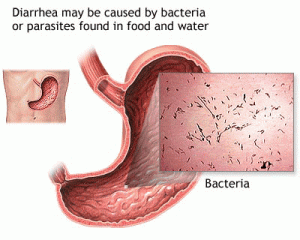

Dysentery is an infection of the intestines that causes diarrhoea containing blood or mucus.
Diarrhoea is the passing of three or more watery stools a day. Other symptoms of dysentery include:
-
stomach cramps
-
nausea (feeling sick)
-
vomiting
Most people who get dysentery only experience mild symptoms, such as diarrhoea and nausea.
A term applied to a number of intestinal disorders, especially of the colon, characterized by inflammation of the mucous membranes. Types of dysentery: amebic, bacillary, balantidial, malignant, viral.
Causes
Bacterial or viral infection; infestation of protozoa or parasitic worms (see Worms); chemical irritants. Inflammation of the rectum and large intestine, insufficient foods, improper diet, drinking too much liquid with meals, overeating, wrong combinations of foods, stimulating foods, liquor, tea, coffee, drinking impure water, unhygienic surroundings, eating fruits or vegetables that have begun to decompose, eating foods that have been standing in pantries that are not well ventilated, and eating improperly refrigerated, contaminated foods. Irritated bowels, habitual constipation, and taking certain types of medicine, such as laxatives, may also be the cause.
Symptoms
Abdominal pain, tenesmus (spasmodic contractions of anal or vesicle sphincter with pain and persistent desire to empty the bowel or bladder, with involuntary ineffectual straining efforts), diarrhea with passage of mucus or blood. More or less fever, loss of appetite, sleeplessness, and restless at night. Sometimes the abdomen is distended. Severe symptoms: Increasing fever, great thirst, red tongue, the abdomen may appear sunken in some cases, straining ceases, and the bowels become relaxed and may protrude. Passage of urine is infrequent and is accompanied by a burning sensation. The pulse becomes slow, breathing is rapid, and generally the patient looks pale and emaciated. Do not let this condition continue. See a doctor for the severe symptoms.
Types of dysentery
There are two main types of dysentery:
-
bacillary dysentery or shigellosis – caused by shigella bacteria, this is the most common type of dysentery in the UK
-
amoebic dysentery or amoebiasis – caused by an amoeba (single-celled parasite) called Entamoeba histolytica, found mainly in tropical areas, so this type of dysentery is picked up abroad
Both types of dysentery are commonly passed on through poor hygiene and people often become infected by eating contaminated food.
Preventing dysentery
To minimise the risk of catching the condition, you should:
-
wash your hands with soap and water after using the toilet
-
wash your hands before handling, eating or cooking food
-
wash the laundry of an infected person on the hottest setting possible
If travelling to an area with poor sanitation:
-
drink bottled water (make sure the seal is intact)
-
do not have ice in your drinks
-
do not eat fresh fruit or vegetables that cannot be peeled before eating
-
avoid eating food or drink bought from street vendors (except drinks from properly sealed cans or bottles)
How common is dysentery?
Outbreaks of bacillary dysentery are common. In 2010, there were over 1,700 cases of dysentery in the UK caused by the shigella bacteria. However, there are many more cases that are not reported.